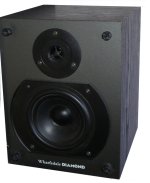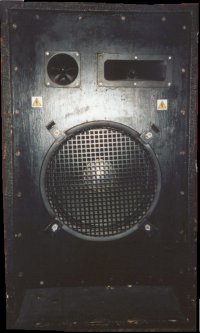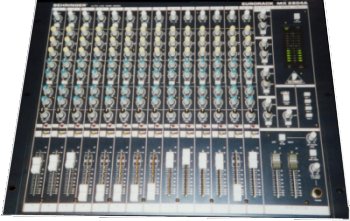

|
||||||
Older devices no longer used in the studio
Old monitors - Wharfedale Diamonds
Old monitors - home built monitors
These have now been replaced by the above systems, but don't worry, they still re-appear for the odd party!
The Mixer
The mixer
has enough inputs for everything I need and there is still some spare
and there are enough auxes for my requirements. Mic inputs are provided
but I don't invisage using more than one of these - unless - hey! I
could mic up my
drumkit! Yes!!
I had a problem with
this unit as one day for no reason it didn't power on and the lights
went mad and there was no sound. I returned to Behringer who charged
100-200 uk pounds to fix and it turned out to be a decoupling capacitor
on an IC!
I notice this unit gets -very- hot after a couple of hours of
use as well, I think it needed a fan or something installed, or maybe
just different electronics! I'd be interested to know if anyone else
has had heat problems with this model or similar.
Recording gear
- Expander section
- Compressor section
- Peak limiting section
1 - the
expander cuts the level dramatically when a lower threshold has been
reached, the idea being that noise is removed when there is nothing
desirable to record.
2 - the compressor can vary in complexity but always has a desired level you set, above which the gain is reduced so the level does not exceed that level. There is invariably a ratio control (calibrated 1:1 , 2:1 etc to 1:infinity) which determines the effectiveness of the compression. 4:1 is supposed to be a good starting point. The Behringer also has attack and release controls which can be set to auto.
3- the
limiter abruptly cuts the level above a set threshold , useful for
removing heavy spikes but will adversely affect the sound if used too
heavily.
On the Behringer the two channels can be synced, essential for stereo use and there are many other features such as sidechain which allows an auxillary sound source to affect how the compression works.
Old Minidisc(tm)* recorder
For a while I used a 'Hifi' minidisc deck to master all of my tracks,
but now I tend to save the raw WAVs and copy to CD when required.
After trying to use high quality tapes it was wonderful. Gone
are the
days of not knowing where on a tape a track is or finding undesirable
glitches in the recording.
Though minidisc* is not supposed to be up to the recording standards of DAT or ADAT etc, when I used to use the MD I didn't notice any sound degradation when mastering anything I had created in comparison to the original. This is in stark contrast to the problems I have had using MP3 compression. I guess the guys at Sony had time to perfect their 'ATRAC' compression algorithm.
For those who don't know, the disks are very handy in physical size and you can store track names and disk names so you know which is which just by flicking through. Some disks come with a nice selection of labels and protective covers and there is software for your computer to automatically print the labels with designs of your choice.
So impressed by the Minidisc was I that I immediately bought a second recorder! This time in the format of a walkman which I now use with a stereo mic to grab sounds out and about. The unit has been to Venice, Dublin, Milano to name three (in the course of work) and has recorded many interesting sounds I am now using in new tracks.
Apparently
Kiss 100 are using Sony MD for all their jingles (and other stuff too?).
*Minidisc
is a trademark of Sony Corp.
Tracked by dancecrave";
?>





